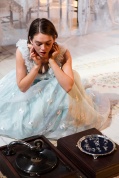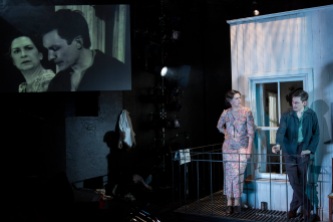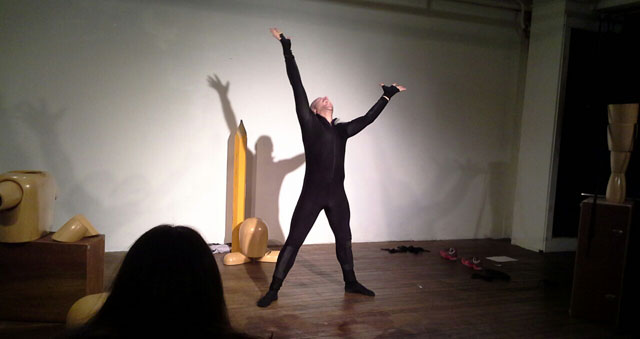Venue: Belvoir St Theatre (Surry Hills NSW), Sep 20 – Nov 2, 2014
Playwright: Tennessee Williams
Director: Eamon Flack
Cast: Harry Greenwood, Luke Mullins, Pamela Rabe, Rose Riley
Images by Brett Boardman
Theatre review (originally published at Auditorium Magazine)
Tennessee Williams refers to The Glass Menagerie as a memory play. The work is semi-autobiographical, inspired by events, people and recollections from his own life. The making of art often involves the search for an understanding of the artists’ self and their immediate environment, through the expression of subjects that are familiar and intimate. Williams’ story examines the home life he had shared with an overbearing mother and a “crippled” sister. Seventy years have past since its initial staging, but their life together remains intriguing and poignant, covering timeless and universal themes that resonate with audiences today the world over. Film adaptations from India and Iran in the last decade demonstrate the wide appeal of the play’s premise and characters.
Williams’ language is romantically evocative of the American South in the 1930s, with old fashioned values that seem quaint and charming to our modern sensibilities, but that same regressiveness in attitude can prove to be harmful, as witnessed in the Wingfield family’s tribulations. Amanda has a definite, and narrow, view of the world and expects her children’s adherence to her every imagined obligation to society. It is a small mind that rules the household, and its painful repercussions are felt by all its members, including the matriarch herself. Eamon Flack’s direction is punctuated by inventive touches, but it is his effective exploration of the original’s concepts that strikes a chord.
A key feature of the production involves two large screens flanking the set, and several video cameras on tripods positioned on the periphery of the stage. Close ups of live action are periodically projected in black and white, shifting the audience between modes of theatre and cinema. This mechanism is slightly gimmicky, but it enriches the viewing experience by allowing an intrusion into more private spaces. Sean Bacon’s work on video design manages to bring elegance to the technology, finding a beautiful balance between stage and screen, rarely causing conflict or confusion for our eyes. Flack’s decision to have faces enlarged for our viewing pleasure enhances emotion and empathy for the piece, but it also brings into doubt the strength of performances that require that augmentation.
Also intensified in Flack’s direction is Tom Wingfield’s homosexuality. Before Williams’ lines are able to reveal the source of Tom’s disquiet, we observe from the very beginning, actor Luke Mullins’ purposeful flamboyance eagerly presenting an image of repressed and hidden gayness. The negation of that obsolete taboo inherent in the text, is an interesting and politically appropriate move for our times, and we are glad to see Tom, our narrator, approach us with fresh honesty. In terms of dramatic structure however, the build up of frustration and tension resulting from his gradual and inevitable disclosures is thus omitted.
Mullins is delightfully spirited in the role. He finds many opportunities for playfulness that helps maintain an electric atmosphere, regardless of moods being portrayed. The staidness of his home is placed alongside a confident showmanship that ensures entertainment in spite of the play’s many grim turns. Within the script’s shrewd treatment of secret sexuality, Mullins exercises a surprising range of nuance that conveys as much as Williams had tried to conceal.
The role of Amanda, the Wingfield mother and faded Southern belle, is played by Pamela Rabe who excels at locating authenticity in a highly dramatised character. Obsessive concern becomes comprehensible in Rabe’s depiction, thereby giving the tale its emotion and meaning. The woman’s severity leads to her own anguish, both qualities delivered by the actor with firm conviction. Amanda’s neurosis is strangely subdued at the play’s early stages, which slightly dampens the drama surrounding family dynamics, but when her hysteria sets in, its theatrical effects are quite wonderful.
Rose Riley’s interpretation of Laura is a fascinating one. Her family believes her to be disabled, but we do not see much evidence for it. The ambiguity surrounding Laura’s impairment sheds light on the changes in attitude over time that societies hold for notions of health and normalcy. Riley puts on an intense but introspective performance and her best moments occur when the camera catches her face in tight shots, revealing very strong and genuine outpouring of emotion. She is the perfect counterpoint to the loudness of her mother and brother, but a lengthy scene with a romantic interest Jim (Harry Greenwood) is unduly quiet and both actors’ subtlety leaves a blemish on an otherwise dexterously paced show.
Set design by Michael Hankin manufactures a sense of claustrophobia with the very small Wingfield home. An unbearable pressure exists together with their poverty, and their dysfunction becomes logical. The aesthetics of the production is fairly muted, with an emphasis on accuracy over theatricality, but Damien Cooper finds opportunities with his lighting design to implement instances of creative flair that add sensual and shifting textures to the plot.
Tom, like his father and his author, escapes oppression in search of a greater truth. The most significant of America’s patriotic qualities is freedom, and The Glass Menagerie gifts us a portrait of its opposite. Enslaved by archaic beliefs and antiquated values, the play’s characters endure a continuance of suffering and painful delusion. Today, the story looks to be a relic of a bygone era, but in fact, that same denial of liberty persists in our personal and social spheres, albeit in insidiousness. The play’s optimistic conclusion sees Tom taking action to remove his psychological shackles. The act seems at once desperately painful, and plainly simple.


















 Venue: Old 505 Theatre (Surry Hills NSW), Sep 17 – 28, 2014
Venue: Old 505 Theatre (Surry Hills NSW), Sep 17 – 28, 2014 What is your favourite swear word?
What is your favourite swear word? Venue: New Theatre (Newtown NSW), Sep 19 – 27, 2014
Venue: New Theatre (Newtown NSW), Sep 19 – 27, 2014 Venue: PACT (Erskineville NSW), Sep 24 – 27, 2014
Venue: PACT (Erskineville NSW), Sep 24 – 27, 2014
 Venue: Eternity Playhouse (Darlinghurst NSW), Sep 19 – Oct 19, 2014
Venue: Eternity Playhouse (Darlinghurst NSW), Sep 19 – Oct 19, 2014
 Venue: New Theatre (Newtown NSW), Sep 15 – 22, 2014
Venue: New Theatre (Newtown NSW), Sep 15 – 22, 2014 Venue: New Theatre (Newtown NSW), Sep 17 – 21, 2014
Venue: New Theatre (Newtown NSW), Sep 17 – 21, 2014